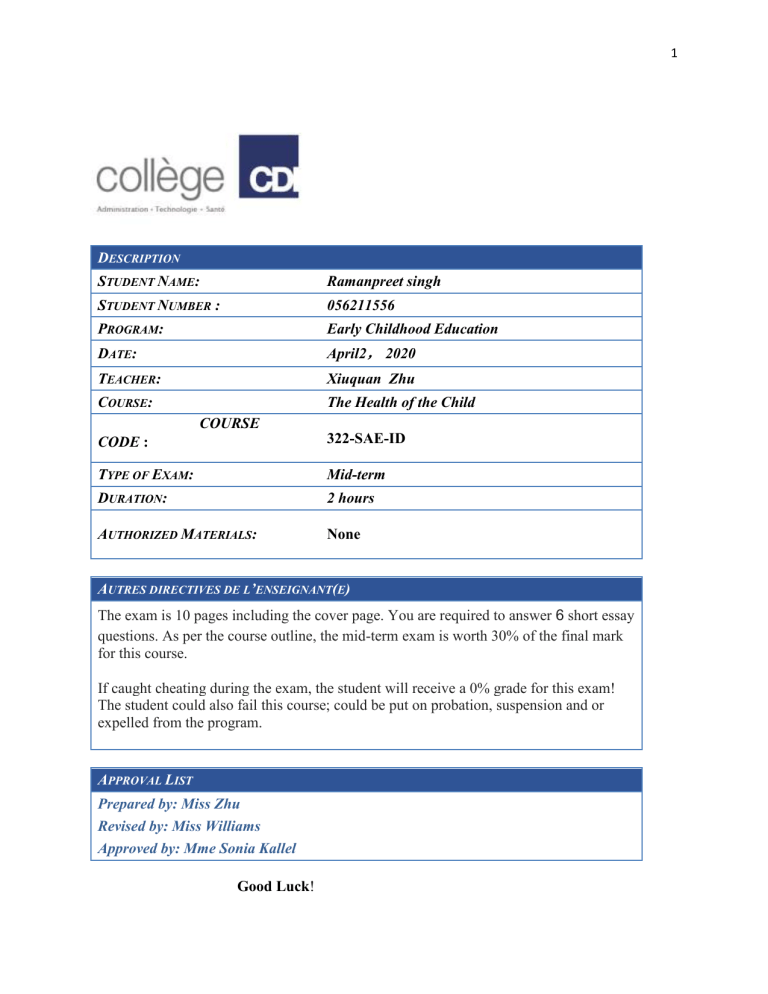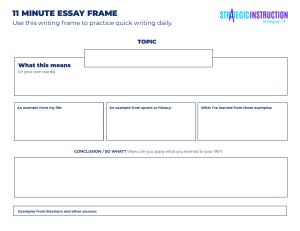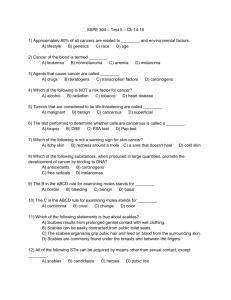
1 DESCRIPTION STUDENT NAME: Ramanpreet singh STUDENT NUMBER : 056211556 PROGRAM: Early Childhood Education DATE: April2, 2020 TEACHER: Xiuquan Zhu COURSE: The Health of the Child COURSE CODE : 322-SAE-ID TYPE OF EXAM: Mid-term DURATION: 2 hours AUTHORIZED MATERIALS: None AUTRES DIRECTIVES DE L’ENSEIGNANT(E) The exam is 10 pages including the cover page. You are required to answer 6 short essay questions. As per the course outline, the mid-term exam is worth 30% of the final mark for this course. If caught cheating during the exam, the student will receive a 0% grade for this exam! The student could also fail this course; could be put on probation, suspension and or expelled from the program. APPROVAL LIST Prepared by: Miss Zhu Revised by: Miss Williams Approved by: Mme Sonia Kallel Good Luck! 2 Short Essay Questions ( /95) Essay question 1 ( /25) A mother is concerned about her child playing outdoors because it is starting to get cold. She also tells you that outdoor play seems to be a complete waste of her child’s time and expresses her concerns about her child’s safety. Write a letter to the mother to reassure regarding her concerns Be sure to include the benefits of outdoor play and how you can keep children safe during outdoor play. Please use objective language and an appropriate tone to write the letter. Answer 1. Dear mother, We respect your concern about your child doing outdoor activities in this cold weather. But we anticipate such obstacles too. Our staff is well trained in taking care of children in all circumstances. We provide snow jackets, caps gloves, and snowshoes to make sure they are safe while taking them outside the building. However, children are only taken out when it is safe to do. We cannot sacrifice the benefits child can get by playing outdoor games. Children get exposure to bright light, that enhances health and mental performance. Increase activity levels, and greater freedom to run, jump, and climb, which is good for heart, lungs and overall muscle development. Reduced stress levels, better moods, and improved concentration. Improved and quality sleep due to the fatigue, Opportunities to learn social skills, overcome fears 3 Develop a connection with nature. Lastly there is always a teacher with children to supervise them and we keep our playground well maintained and equipment under check. So, you can be relaxed about your child Your sincerely, Ramanpreet Singh Essay question 2 ( /20) You want to write a letter to parents informing them about scabies. Your letter should be informative but your tone should be sensitive. Be sure to include the definition and symptoms of scabies, how it’s spread and how to treat this infectious disease. Answer 2 Dear parents, This letter is to inform you about an infectious disease. Scabies, it is very common disease and spread quickly through close physical contact in a family and by using towels, bedding or clothes with someone who has it. Having scabies does not mean that someone is not clean. Scabies is an itchy skin condition caused by a tiny burrowing mite called Sarcoptes scabiei. Intense itching occurs in the area where the mite burrows. The urge to scratch may be especially strong at night. Scabies signs and symptoms include: The mites that cause scabies dig deep into the skin, and cause itching. This leads to a rash that is very itchy and red. Itchiness is usually worse at night this can also lead to thick crust on the skin. The rash usually appears between the fingers, between toes or around. Babies can have rashes on their face scalp (especially behind the ears). 4 For adults, the bumps usually are on the fingers, wrists, and arms but can be anywhere on the body [except on an adult’s face]. Scabies is treated by a cream or a lotion that is prescribed bye by a doctor. People with scabies may need to do two treatments, 1 week apart. A child may still be itchy for a few weeks. It does not mean that the mites are still there. To prevent scabies from coming back, everyone who lives in home will need to be treated at the same time. Essay Question 3 ( /15) Whenever children are together, there is a chance of spreading infections. This is especially true among infants and toddlers who are likely to use their hands to wipe their noses or rub their eyes and then handle toys or touch other children. What can educators do to reduce the spread of illness in childcare setting? Answer 3 Whenever children are together, there is a chance of spreading infections. This is especially true among infants and toddlers who are likely to use their hands to wipe their noses or rub their eyes and then handle toys or touch other children. In many child care facilities, the staff simply cannot care for a sick child due to lack of space or staff limitations, although in others, the child can be kept comfortable and allowed to rest as needed in a separate room where they have already exposed the other children. . When waiting to be picked up, an ill child who is being excluded should be in a location when no contact occurs with those who have not already been exposed to their infection. In some programs, a staff member who knows the infected child well and who is trained to take care for ill children may care for the child to a space set aside for such care and where others will not be exposed. Even with all these prevention measures, it is likely that some infections will be spread in the childcare center. For many of these infections, a child is contagious a day or more before he has symptoms. Be sure to wash your and your child's hands frequently. 5 You never know when your child or another child is passing a virus or bacteria. Sometimes your child will become sick while at childcare and need to go home. You will need to have a plan so someone can pick him up. See When to Keep Your Child Home from Child Care. Hygiene is the key to prevent such disease Are the toilets and sinks clean and readily available for the children and staff? Are disposable paper towels used so each child will use only his own towel and not share with others? Are toys that infants and toddlers put in their mouths sanitized before others can play with them? Are there sinks in every room, and are there separate sinks for preparing food and washing hands? Is food handled in areas separate from the toilets and diaper-changing tables? Are children and their caregivers or teachers instructed to wash their hands throughout the day, including: 1. When they arrive at the facility 2. Before and after handling food, feeding a child, or eating 3. After using the toilet, changing a diaper, or helping a child use the bathroom (Following a diaper change, the caregiver's and child's hands should be washed and the diaper-changing surfaces should be disinfected.) 4. After helping a child wipe his nose or mouth or tending to a cut or sore 5. After playing in sandboxes 6. Before and after playing in water that is used by other children 7. Before and after staff members give medicine to a child 8. After handling wastebaskets or garbage 9. After handling a pet or other animal Is health consultation available to deal with outbreaks or to review policies? 6 Essay Question 4 (15) Discuss an animated way to teach proper hand washing technique to your daycare students. Be sure to include the ten steps to proper hand washing and two different ways to teach children hand washing. Answer 4 Hygiene is the key to live a healthy life and be safe from infectious disease. Hand washing is fundamental in hygiene. Thus, it needs to be taught to children from the early stage of life. Animated movies or clips are the bests way to teach children how to wash hands properly. Not only washing hands is compulsory but washing hands properly is must. 10 steps to wash hands properly are mentioned below. 1. Wet your hands wrists in water. 2. Put soap on your hands. 3. Rub your hands together both, inside and top of your palms. 4. Clean thoroughly between your fingers. 5. Carefully clean the tips of your fingernails. 6. Do not forget your wrists. 7. Rinse with lots of water. 8. Dry your hands and wrists with paper towels. 9. Ask adult to turn off the taps with a paper towel. 10. Then throw it in the garbage. 7 Essay Question 5 (10) In your daycare class, a child named Peter suddenly has febrile seizures. How will you deal with this situation? What if you cannot reach the parents? A febrile seizure, also known as a fever, is a seizure associated with an increased body temperature but without any serious underlying health issue. It most commonly occurs in children between the ages of 6 months and 5 years. In daycare if a child has febrile seizures, informing parents is must. However, according the question in Peter’s case if their parents cannot be contacted then in such scenario child should be given first aid treatment, thus, in every daycare there must be a fist aid kit placed in easy reach and every daycare teacher must have knowledge about this treatment; First aid treatment for a febrile seizure 1) Note the time the seizure started. 2) Place the child on their side, use a soft surface. 3) Take away hazards or sharp objects from around the child. 4) Remove extra clothing to help cool the child. 5)Turn their head to a side so that Saliva or Vomit can drain out. 8



